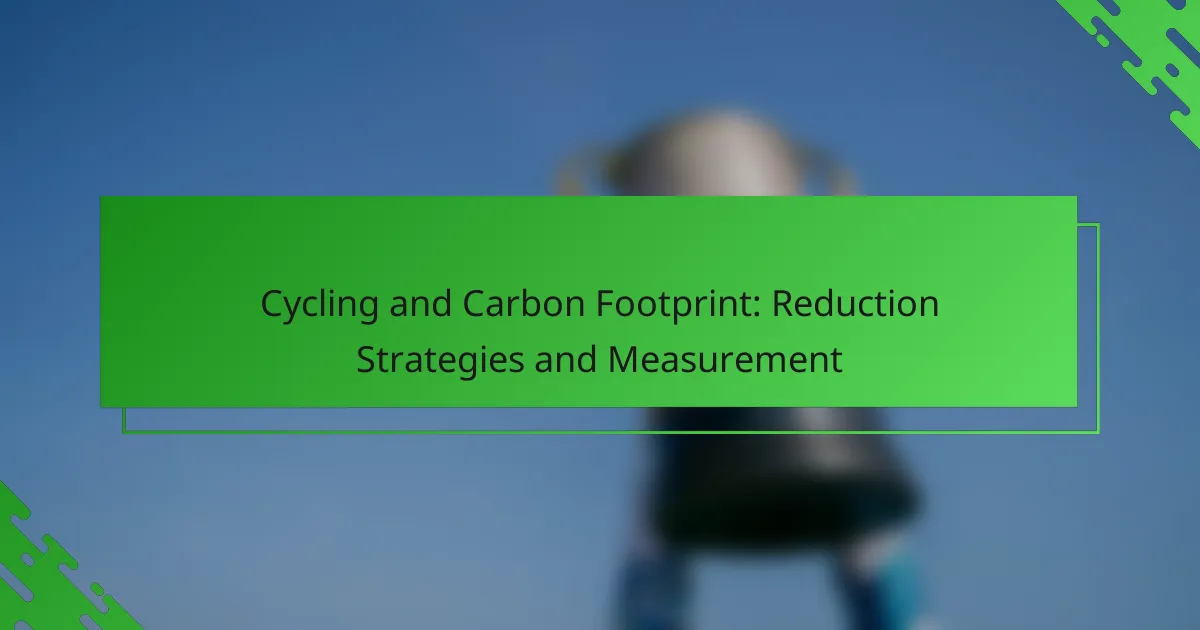Cycling is a powerful tool for improving urban air quality and reducing traffic congestion. It lowers vehicle emissions and promotes healthier lifestyles among residents. Younger adults are increasingly adopting cycling due to environmental awareness and improved infrastructure. Cities can enhance cycling rates through dedicated bike lanes, community programs, and safety measures.

How does cycling contribute to improved urban air quality?
Cycling significantly improves urban air quality by reducing vehicle emissions. As a sustainable commuting option, it decreases reliance on fossil fuels, leading to lower levels of pollutants such as nitrogen oxides and particulate matter. Studies show that cities promoting cycling experience a notable decline in air pollution levels, enhancing public health and environmental conditions. This shift not only benefits air quality but also encourages a healthier lifestyle among urban residents.
What are the major pollutants reduced by cycling?
Cycling significantly reduces major pollutants such as carbon dioxide, nitrogen oxides, and particulate matter. These reductions improve urban air quality and promote healthier environments. The shift from motor vehicles to bicycles decreases greenhouse gas emissions, contributing to climate change mitigation. Additionally, cycling decreases traffic congestion, further lowering pollution levels in urban areas.
How does cycling compare to other modes of transport in emissions reduction?
Cycling significantly reduces emissions compared to other transport modes. Bicycles produce zero emissions during use, while cars emit an average of 404 grams of CO2 per mile. Public transport options like buses and trains also emit less than cars, but cycling remains the cleanest choice. Studies show that increasing cycling in urban areas can lower overall traffic emissions by up to 30%. This unique attribute of cycling helps improve urban air quality and promotes sustainable commuting practices.
What role do cycling infrastructure and policies play in air quality improvement?
Cycling infrastructure and policies significantly enhance urban air quality by reducing vehicular emissions. Investments in bike lanes and bike-sharing programs encourage cycling, leading to fewer cars on the road. For instance, cities with extensive cycling networks have reported a decrease in particulate matter levels by up to 30%. Effective policies, such as incentives for cyclists and restrictions on car use in certain areas, further promote this shift. As a result, improved air quality contributes to better public health and a more sustainable urban environment.

Why is cycling an effective solution for urban traffic congestion?
Cycling effectively reduces urban traffic congestion by providing a space-efficient mode of transportation. It decreases the number of vehicles on the road, leading to less gridlock and shorter travel times. Additionally, cycling contributes to improved air quality by reducing emissions from motor vehicles. Studies show that cities promoting cycling see a significant drop in pollutants, which benefits public health. Urban areas with extensive cycling infrastructure report higher rates of cycling, indicating that investment in bike lanes and facilities encourages this eco-friendly commuting option.
What are the traffic reduction statistics associated with increased cycling?
Increased cycling can reduce urban traffic by up to 30%. Cities that promote cycling see significant decreases in vehicle congestion. For instance, Amsterdam reports a 25% drop in car traffic due to cycling initiatives. Additionally, studies show that every 1% increase in cycling can lead to a 0.5% reduction in traffic volume. This shift not only alleviates congestion but also enhances urban air quality.
How does cycling influence overall road safety in urban areas?
Cycling significantly enhances overall road safety in urban areas by reducing vehicle traffic and promoting safer streets. Increased cycling lowers the number of cars, which decreases the likelihood of accidents. Studies show that for every 10% increase in cycling, traffic fatalities decline by approximately 2%. Furthermore, dedicated bike lanes encourage safer interactions between cyclists and motorists. Enhanced visibility and awareness of cyclists lead to more cautious driving behaviors. Overall, cycling fosters a culture of safety and responsibility on urban roads.
What are the economic benefits of reduced traffic congestion from cycling?
Reduced traffic congestion from cycling provides significant economic benefits. It lowers costs associated with road maintenance and healthcare while increasing productivity. Cycling reduces the need for extensive infrastructure, saving cities money on construction and upkeep. Additionally, improved air quality from decreased vehicle emissions can lead to lower healthcare expenses, enhancing public health and reducing economic burdens. Studies show that every mile cycled can save cities approximately $0.16 in road maintenance costs.

Which demographics are most likely to adopt cycling as a commuting option?
Younger adults and urban residents are most likely to adopt cycling as a commuting option. Studies show that individuals aged 18 to 34, particularly in metropolitan areas, demonstrate higher cycling rates. Factors influencing this trend include environmental awareness, health benefits, and the increasing availability of cycling infrastructure. Additionally, socio-economic status plays a role; those with higher income levels are more inclined to invest in bicycles and related gear. As cities prioritize green commuting initiatives, cycling adoption is expected to rise among diverse demographic groups.
How do cultural attitudes towards cycling differ across regions?
Cultural attitudes towards cycling vary significantly across regions. In European countries, cycling is often seen as a primary mode of transportation, supported by extensive infrastructure and policies promoting green commuting. In contrast, in North America, cycling is frequently viewed as a recreational activity rather than a viable commuting option, leading to less investment in cycling infrastructure.
In Asia, attitudes can differ widely; cities like Amsterdam and Copenhagen prioritize cycling, while others may lack the necessary infrastructure. Urban air quality improvements linked to cycling are more pronounced in regions where cycling is culturally embraced, resulting in lower traffic congestion and reduced emissions.
As a result, cities promoting cycling not only enhance air quality but also foster a healthier lifestyle among residents. This cultural shift towards cycling can significantly impact urban planning and public health initiatives.
What barriers exist for specific populations in adopting cycling?
Barriers for specific populations in adopting cycling include safety concerns, lack of infrastructure, and socioeconomic factors. Vulnerable groups like children, the elderly, and low-income individuals face unique challenges. For instance, inadequate bike lanes increase the risk of accidents, deterring potential cyclists. Additionally, financial constraints limit access to bicycles and safety gear, further hindering adoption.
What incentives can encourage more people to cycle?
Incentives such as improved cycling infrastructure, financial subsidies, and community programs can encourage more people to cycle. Enhanced bike lanes and secure parking increase safety and accessibility. Financial incentives, like tax breaks or rebates for purchasing bikes, lower entry barriers. Community programs promoting cycling events foster social engagement and awareness. As a result, these measures can significantly improve urban air quality and reduce traffic congestion.

What unique attributes make cycling a preferred choice for green commuting?
Cycling is preferred for green commuting due to its minimal environmental impact and health benefits. It significantly reduces carbon emissions, improves urban air quality, and decreases traffic congestion. Unique attributes include its ability to promote physical fitness and its cost-effectiveness compared to motorized transport. Cycling infrastructure also fosters community engagement and urban livability.
How does cycling impact mental health and well-being?
Cycling positively influences mental health by reducing stress and anxiety. Regular cycling enhances mood and promotes overall well-being. Studies show that physical activity, like cycling, increases endorphin levels, leading to improved mental clarity and emotional resilience. Additionally, cycling boosts self-esteem through physical fitness and social interaction, fostering a sense of community.
What are the social benefits of cycling in urban communities?
Cycling in urban communities provides significant social benefits, enhancing community interaction and public health. It fosters social connections as cyclists engage with one another, promoting a sense of belonging. Increased cycling reduces traffic congestion, leading to less stress and improved quality of life.
Moreover, cycling contributes to cleaner air, directly impacting public health by reducing respiratory issues linked to pollution. Communities that prioritize cycling often see a rise in local businesses, as cyclists are more likely to stop and shop. Overall, cycling strengthens community ties while promoting a healthier environment.
What innovative cycling programs have emerged in major cities?
Innovative cycling programs in major cities focus on enhancing urban air quality and reducing traffic congestion. Cities like Amsterdam and Copenhagen have implemented extensive bike-sharing systems and dedicated cycling lanes. These initiatives promote green commuting and significantly lower carbon emissions. For instance, a study found that increasing cycling by 10% can reduce urban air pollution by 25%. Furthermore, cities are integrating smart technology to optimize bike routes and monitor air quality, contributing to sustainable urban mobility.

What are the rare but impactful benefits of cycling on urban ecosystems?
Cycling positively impacts urban ecosystems by enhancing air quality and reducing traffic congestion. It lowers carbon emissions, leading to cleaner air. Additionally, cycling promotes biodiversity by reducing noise pollution and encouraging green spaces. Studies show that cities with higher cycling rates experience improved public health outcomes, including lower respiratory issues.
How does cycling contribute to urban biodiversity?
Cycling enhances urban biodiversity by promoting green spaces and reducing pollution. Increased cycling leads to fewer vehicles on the road, resulting in lower emissions and improved air quality. This helps create healthier ecosystems and supports diverse plant and animal life. Additionally, cycling infrastructure can incorporate green corridors, fostering habitats for wildlife. Urban areas with more cyclists often see a rise in community gardens and green roofs, contributing to greater biodiversity.
What are the long-term effects of cycling on urban heat islands?
Cycling can significantly mitigate urban heat islands over the long term. Increased cycling reduces vehicle emissions and promotes vegetation growth, which cools urban areas. Studies indicate that cities with higher cycling rates experience lower ambient temperatures, enhancing air quality. Additionally, cycling infrastructure contributes to sustainable urban planning, fostering green spaces that further combat heat accumulation.
How can cycling infrastructure support wildlife corridors?
Cycling infrastructure can significantly support wildlife corridors by creating safe passageways for animals. Enhanced bike paths can minimize road crossings and reduce vehicle traffic, which lowers the risk of wildlife collisions.
Integrating green spaces along cycling routes encourages biodiversity and connects fragmented habitats. For instance, urban bike lanes designed with native vegetation can provide shelter and food sources for various species.
Additionally, cycling infrastructure can promote community awareness about wildlife conservation. Educational signage along bike paths can inform cyclists about local fauna, fostering a sense of stewardship.
Overall, developing cycling infrastructure not only benefits urban air quality but also plays a crucial role in maintaining ecological balance by supporting wildlife corridors.

What best practices can cities implement to promote cycling effectively?
Cities can promote cycling effectively by implementing dedicated infrastructure, awareness campaigns, and safety measures.
1. Build extensive bike lanes that are separated from motor traffic to enhance safety.
2. Introduce bike-sharing programs to increase accessibility and convenience.
3. Organize community events that encourage cycling and raise awareness about its benefits.
4. Implement traffic calming measures to reduce vehicle speeds in urban areas.
5. Provide secure bike parking facilities to protect against theft.
6. Educate citizens on the environmental and health benefits of cycling.
These practices can significantly reduce urban air pollution and improve overall traffic flow.
What are the key features of successful cycling infrastructure?
Successful cycling infrastructure includes dedicated bike lanes, safe intersections, bike parking, and connectivity to public transport. These features enhance urban air quality and reduce traffic congestion.
1. Dedicated bike lanes: Provide safety and encourage more cyclists, leading to decreased vehicle emissions.
2. Safe intersections: Implementing bike signals and crosswalks reduces accidents and promotes cycling.
3. Bike parking: Convenient and secure storage encourages cycling as a viable commuting option.
4. Connectivity: Linking cycling routes to public transport increases accessibility and reduces reliance on cars.
How can community engagement enhance cycling initiatives?
Community engagement significantly enhances cycling initiatives by fostering collaboration and building support among residents. Engaged communities are more likely to advocate for cycling infrastructure, leading to improved urban air quality and reduced traffic congestion. Studies show that cities with strong community involvement in cycling programs experience a 30% increase in cycling participation. This shift not only promotes healthier lifestyles but also contributes to a 20% reduction in local carbon emissions. By prioritising community input, cities can tailor cycling initiatives to meet the specific needs of their residents, ensuring greater success and sustainability.
What common mistakes should cities avoid when promoting cycling?
Cities should avoid common mistakes like insufficient infrastructure, neglecting community engagement, and failing to promote safety. These errors hinder cycling adoption and negatively impact urban air quality.
1. Inadequate bike lanes: Without dedicated lanes, cyclists face safety risks, deterring potential riders.
2. Ignoring public input: Failing to involve the community can lead to solutions that do not meet local needs.
3. Lack of safety measures: Not implementing safety features, such as signage and traffic calming, can increase accidents.
4. Poor maintenance: Neglecting bike paths and parking facilities can discourage cycling.
5. Insufficient promotion: Cities must actively market cycling benefits to encourage participation.
6. Overlooking accessibility: Not considering diverse user needs limits cycling’s reach within the community.



